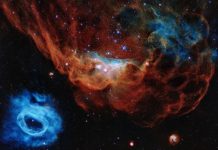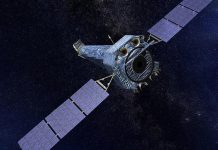
PASADENA, Calif., Oct. 7 (UPI) — NASA’s Hubble Space Telescope has captured images of large plasma “cannonballs” being ejected from the vicinity of V Hydrae, a bloated red giant located 1,200 light-years from Earth.
Researchers believe the hurled blobs of plasma may explain the formation of planetary nebulae.
Hubble data suggests the cannonballs are roughly twice the size of Mars and travel at speeds fast enough to span the distance between Earth and the moon in just 30 minutes. A single blob is fired every 8.5 years. Astronomers estimate the stellar cannon has been firing plasma balls for at least 400 years.
Scientists can’t quite fully explain the phenomena. The red giant from which the blobs appear to originate can’t account for the ejected material. Instead, astronomers suggest an unseen companion star is the progenitor.
Though the discovery presented a puzzle, it also offered answers to long-asked questions.
Planetary nebulae appear as evocative bulbous swirls of glowing gas surrounding dead or dying stars. Each one is unique, assuming a variety of colors, shapes and sizes. Researchers haven’t been able to explain exactly how planetary nebulae come to be, but V Hydrae may offer a glimpse into their formation.
“We knew this object had a high-speed outflow from previous data, but this is the first time we are seeing this process in action,” Raghvendra Sahai, an astronomer at NASA’s Jet Propulsion Laboratory, explained in a news release. “We suggest that these gaseous blobs produced during this late phase of a star’s life help make the structures seen in planetary nebulae.”
Images from Hubble’s Imaging Spectrograph revealed blobs at varying distances from the V Hydrae system. Some shots show recently ejected blobs, while others capture blobs 37 billion miles away from the stellar pair.
When researchers designed a model to account for the launched blobs, they found the best explanation was an accretion disk surrounding the red giant’s presumed companion.
“Red giants don’t have accretion disks, but many most likely have companion stars, which presumably have lower masses because they are evolving more slowly,” Sahai explains. “The model we propose can help explain the presence of bipolar planetary nebulae, the presence of knotty jet-like structures in many of these objects, and even multipolar planetary nebulae. We think this model has very wide applicability.”
Though the longevity of the cannonball phenomena suggests the stellar companion and its accretion disk are relatively stable, most companions are eventually pulled into and consumed by their big, red partner.
“The orbit of V Hydrae’s companion will continue to decay because it is losing energy in this frictional interaction,” Sahai added. “However, we do not know the ultimate fate of this companion.”






